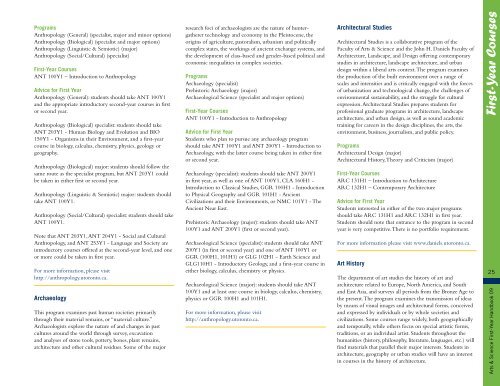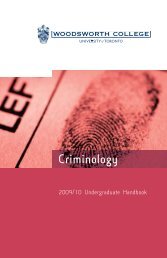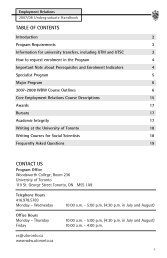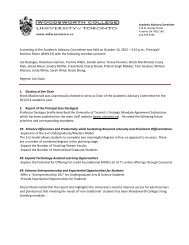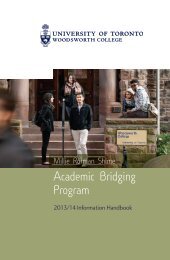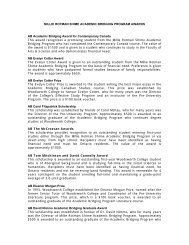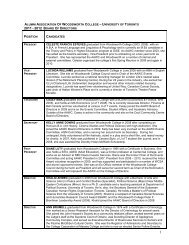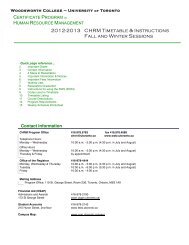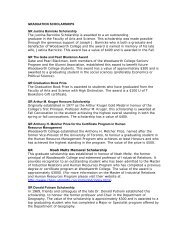First-Year Handbook 2009/10 - Woodsworth College - University of ...
First-Year Handbook 2009/10 - Woodsworth College - University of ...
First-Year Handbook 2009/10 - Woodsworth College - University of ...
Create successful ePaper yourself
Turn your PDF publications into a flip-book with our unique Google optimized e-Paper software.
ProgramsAnthropology (General) (specialist, major and minor options)Anthropology (Biological) (specialist and major options)Anthropology (Linguistic & Semiotic) (major)Anthropology (Social/Cultural) (specialist)<strong>First</strong>-<strong>Year</strong> CoursesANT <strong>10</strong>0Y1 – Introduction to AnthropologyAdvice for <strong>First</strong> <strong>Year</strong>Anthropology (General): students should take ANT <strong>10</strong>0Y1and the appropriate introductory second-year courses in firstor second year.Anthropology (Biological) specialist: students should takeANT 203Y1 - Human Biology and Evolution and BIO150Y1 - Organisms in their Environment, and a first-yearcourse in biology, calculus, chemistry, physics, geology orgeography.Anthropology (Biological) major: students should follow thesame route as the specialist program, but ANT 203Y1 couldbe taken in either first or second year.Anthropology (Linguistic & Semiotic) major: students shouldtake ANT <strong>10</strong>0Y1.Anthropology (Social/Cultural) specialist: students should takeANT <strong>10</strong>0Y1.Note that ANT 203Y1, ANT 204Y1 - Social and CulturalAnthropology, and ANT 253Y1 - Language and Society areintroductory courses <strong>of</strong>fered at the second-year level, and oneor more could be taken in first year.For more information, please visithttp://anthropology.utoronto.ca.ArchaeologyThis program examines past human societies primarilythrough their material remains, or “material culture.”Archaeologists explore the nature <strong>of</strong> and changes in pastcultures around the world through survey, excavationand analyses <strong>of</strong> stone tools, pottery, bones, plant remains,architecture and other cultural residues. Some <strong>of</strong> the majorresearch foci <strong>of</strong> archaeologists are the nature <strong>of</strong> huntergatherertechnology and economy in the Pleistocene, theorigins <strong>of</strong> agriculture, pastoralism, urbanism and politicallycomplex states, the workings <strong>of</strong> ancient exchange systems, andthe development <strong>of</strong> class-based and gender-based political andeconomic inequalities in complex societies.ProgramsArchaeology (specialist)Prehistoric Archaeology (major)Archaeological Science (specialist and major options)<strong>First</strong>-<strong>Year</strong> CoursesANT <strong>10</strong>0Y1 - Introduction to AnthropologyAdvice for <strong>First</strong> <strong>Year</strong>Students who plan to pursue any archaeology programshould take ANT <strong>10</strong>0Y1 and ANT 200Y1 - Introduction toArchaeology, with the latter course being taken in either firstor second year.Archaeology (specialist): students should take ANT 200Y1in first year, as well as one <strong>of</strong> ANT <strong>10</strong>0Y1, CLA 160H1 -Introduction to Classical Studies, GGR <strong>10</strong>0H1 - Introductionto Physical Geography and GGR <strong>10</strong>1H1 - AncientCivilizations and their Environments, or NMC <strong>10</strong>1Y1 - TheAncient Near East.Prehistoric Archaeology (major): students should take ANT<strong>10</strong>0Y1 and ANT 200Y1 (first or second year).Archaeological Science (specialist): students should take ANT200Y1 (in first or second year) and one <strong>of</strong> ANT <strong>10</strong>0Y1 orGGR (<strong>10</strong>0H1, <strong>10</strong>1H1) or GLG <strong>10</strong>2H1 - Earth Science andGLG1<strong>10</strong>H1 - Introductory Geology, and a first-year course ineither biology, calculus, chemistry or physics.Archaeological Science (major): students should take ANT<strong>10</strong>0Y1 and at least one course in biology, calculus, chemistry,physics or GGR <strong>10</strong>0H1 and <strong>10</strong>1H1.For more information, please visithttp://anthropology.utoronto.ca.Architectural StudiesArchitectural Studies is a collaborative program <strong>of</strong> theFaculty <strong>of</strong> Arts & Science and the John H. Daniels Faculty <strong>of</strong>Architecture, Landscape, and Design <strong>of</strong>fering contemporarystudies in architecture, landscape architecture, and urbandesign within a liberal arts context. The program examinesthe production <strong>of</strong> the built environment over a range <strong>of</strong>scales and intensities and is critically engaged with the forces<strong>of</strong> urbanization and technological change, the challenges <strong>of</strong>environmental sustainability, and the struggle for culturalexpression. Architectural Studies prepares students forpr<strong>of</strong>essional graduate programs in architecture, landscapearchitecture, and urban design, as well as sound academictraining for careers in the design disciplines, the arts, theenvironment, business, journalism, and public policy.ProgramsArchitectural Design (major)Architectural History, Theory and Criticism (major)<strong>First</strong>-<strong>Year</strong> CoursesARC 131H1 – Introduction to ArchitectureARC 132H1 – Contemporary ArchitectureAdvice for <strong>First</strong> <strong>Year</strong>Students interested in either <strong>of</strong> the two major programsshould take ARC 131H1 and ARC 132H1 in first year.Students should note that entrance to the program in secondyear is very competitive. There is no portfolio requirement.For more information please visit www.daniels.utoronto.ca.Art HistoryThe department <strong>of</strong> art studies the history <strong>of</strong> art andarchitecture related to Europe, North America, and Southand East Asia, and surveys all periods from the Bronze Age tothe present. The program examines the transmission <strong>of</strong> ideasby means <strong>of</strong> visual images and architectural forms, conceivedand expressed by individuals or by whole societies andcivilizations. Some courses range widely, both geographicallyand temporally, while others focus on special artistic forms,traditions, or an individual artist. Students throughout thehumanities (history, philosophy, literature, languages, etc.) willfind materials that parallel their major interests. Students inarchitecture, geography or urban studies will have an interestin courses in the history <strong>of</strong> architecture.Arts & Science <strong>First</strong>-<strong>Year</strong> <strong>Handbook</strong> 09<strong>First</strong>-<strong>Year</strong> Courses25


